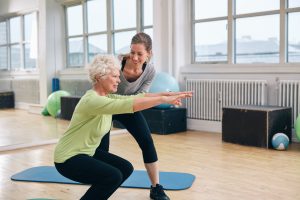 Osteoarthritis is a type of arthritis caused by wear and tear of the joints. This is most common among seniors as the accumulated years of joint movement wears down the cartilage – the protective layer in between the joints – which causes the bones to rub together. This can lead to intense pain, stiffness, and reduced mobility of the joint.
Osteoarthritis is a type of arthritis caused by wear and tear of the joints. This is most common among seniors as the accumulated years of joint movement wears down the cartilage – the protective layer in between the joints – which causes the bones to rub together. This can lead to intense pain, stiffness, and reduced mobility of the joint.
Although osteoarthritis can affect any joint, it is most commonly seen in the knees as they tend to be the most used and bear the most amount of weight. For this reason, you can lower your risk of osteoarthritis by maintaining a healthy weight, controlling your blood sugar, regularly exercising, properly nursing any injuries, and overall living a healthy lifestyle.
Advertisement
More specifically, though, researchers have recently uncovered that maintaining strong thigh muscles is another way to prevent osteoarthritis. (Get up from a chair without struggling.)
Risk of osteoarthritis reduced in women with strong thigh muscles
The study found that women with weak thigh muscles were 47 percent more likely to develop knee osteoarthritis, compared to women with stronger thigh muscles. Known as quadriceps or knee extensors, these muscles help the legs with standing, climbing, kicking, and straightening the leg out.
The link between thigh muscle strength and risk of osteoarthritis was seen among women, but not among men.
Study lead author Dr. Adam Culvenor explained, “While our recent study has highlighted the important role of strong thigh muscles in reducing the risk of knee osteoarthritis development, particularly in women, it is not possible to guarantee that having strong thigh muscles will protect women from developing knee osteoarthritis because there are many other factors that play into the disease. Nevertheless, our results suggest that optimizing quadriceps and hamstring strength may help to lower the risk of developing knee osteoarthritis.”
The researchers examined MRIs of thigh muscles and strength tests taken from 186 participants with knee osteoarthritis and 186 participants without the condition. The researchers also examined participants’ body mass index, as obesity is linked to knee osteoarthritis.
Even after adjusting for body mass index, women with weaker thigh muscles had a 33 percent higher risk of knee osteoarthritis.
Among men, the findings were not statistically significant enough to suggest the same association.
Advertisement
The quadriceps can help prevent the development of knee osteoarthritis by acting as shock absorbers and helping stabilize the knee. If these muscles are weak, there is added stress placed on the knee which, researchers suggest, speeds up the degeneration process. (Don’t let pain control your life… Fight back today!)
As to the differences between men and women, Dr. Culvenor explained, “This is likely because muscles in men with greater body mass have more contractile tissue and strength, whereas in women with greater body mass more non-contractile adipose tissue is deposited within the muscle and hence cannot produce as much force.”
Regardless of your age, you can still work towards strengthening your thigh muscles. Exercises like squats, lunges, and leg presses can work your thigh muscles, helping them to become stronger which in turn helps stabilize the knee joint better. You can work alongside a physiotherapist in order to get back into regular exercise and strengthen your quadriceps without injury.
Related: Osteoarthritis knee pain relief at home: Easy tips and natural remedies
